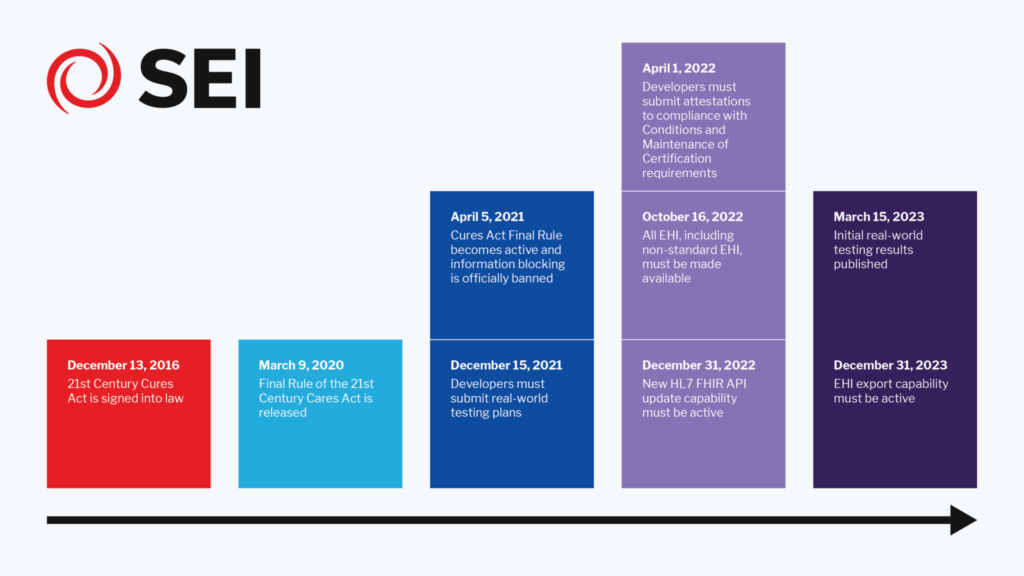The Cures Act, introduced in 2016, was intended to establish a trusted exchange framework between disparate healthcare systems. By developing a technical infrastructure model and governance framework for the healthcare industry, the Cures Act aims to support the safe sharing of patient data between healthcare systems, providers, and IT developers.
Because different healthcare providers use various electronic health record (EHR) platforms, exchanging patient information can often be a challenge. This article will address the root causes of these roadblocks, how the Cures Act attempts to resolve them, and how you can achieve compliance with existing and upcoming legislation.

Why is the Cures Act Important?
Primarily, the Cures Act attempts to resolve the issue of data blocking within the healthcare industry. Data or information blocking happens when healthcare vendors disrupt or prevent the transmission of EHRs and other patient data. Healthcare vendors often knowingly or purposefully partake in data blocking, citing privacy concerns and proprietary rights.
With more than 89% of all hospitals having implemented an inpatient or ambulatory EHR, you can imagine how complex the technological landscape is. Connecting the various systems to facilitate data sharing can be extremely difficult to achieve. As a result, patient data isn’t necessarily shared between separate healthcare institutions. This results in test duplications, high administrative costs, slower access speeds, and can negatively impact quality of care — all of which introduce unnecessary stress and burden into the entire healthcare system.
The Cures Act combats data blocking by prohibiting practices and processes that:
- Prevent patients from accessing their own data
- Inhibit patient information from following one’s healthcare journey
- Stop data from being used to manage patients, research new treatments, and improve care
By deterring data blocking, the Cures Act endeavors to build bridges between disparate healthcare systems and institutions. This will help ensure that all healthcare providers have access to all the information necessary to provide the best care possible.
What to Expect From Upcoming Legislation
The Cures Act will continue its development until 2023, and most likely beyond — but the major Cures Act landmarks are approaching fast. It’s critical that healthcare providers and developers begin implementing changes to ensure compliance with the Cures Act, sooner rather than later, or risk being caught off-guard.
2022 is a big year for the Cures Act. By April 1, 2022, the Attestations to Conditions of Certification (CoC) will begin — which means that development teams will need to meet an array of conditions and requirements by this date. By October 16, 2022, all patient EHRs are required to be sharable. And by the last day of 2022, APIs must be standardized to allow for accessibility and a better flow of patient data.
Complying with the Cures Act — in 2022 and in the coming years — isn’t going to be easy. And the clock’s ticking.
Benefits of Complying with Legislation
Currently, many businesses are being compensated to participate in the initial phases of Cures Act compliance. However, the Cures Act regulations and standards are likely to become compulsory in the coming years — a trend seen in previous healthcare legislation.
Healthcare organizations have the opportunity to get ahead. By starting to comply now, you can benefit from current compensation while implementing the necessary changes at your own pace. This will help you ensure a smooth transition into Cures Act compliance.
It is worth noting that Cures Act compliance offers benefits beyond avoiding penalties. Other benefits include:
- Patients are able to access all their data, captured across healthcare organizations, in a single location. This supports a better patient experience for virtual and in-person visits.
- Providers gain access to a full picture of patient history and data, without relying on out-of-date processes. This allows providers to easily share and access all user information, reducing the need for duplicate tests and minimizing burden on healthcare staff.
- Administrators benefit from reduced duplication of systems, databases, and data entry. This reduces overhead, management, and maintenance of these systems — saving time, energy, and resources.
- Insurance payers are able to more efficiently share information with providers, and keep track of patient data without compromising security.
Complying with the Cures Act also improves the process of reporting to regulatory bodies. This is especially important for COVID-19 reporting and vaccination status updates, which can be particularly burdensome for healthcare organizations.
For the Cures Act, Choose SEI
SEI works with many healthcare providers, helping them maximize the benefits of compliance without falling behind. As experts in the field of healthcare, SEI can be relied upon to help you achieve compliance with the Cures Act and other legislation. Reach out to continue the conversation and get to know us better!



